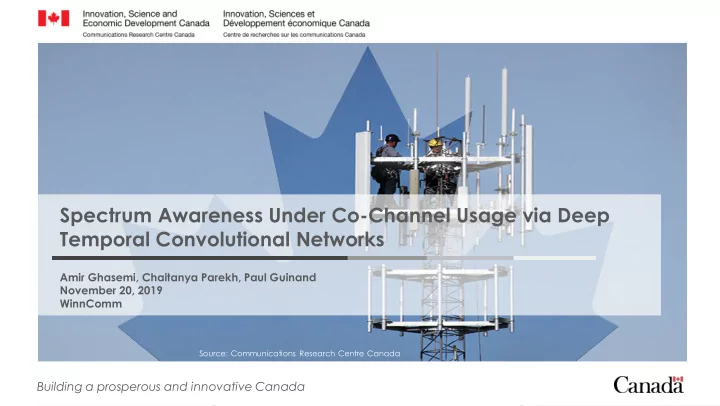

Spectrum Awareness Under Co-Channel Usage via Deep Temporal Convolutional Networks Amir Ghasemi, Chaitanya Parekh, Paul Guinand November 20, 2019 WinnComm Source: Communications Research Centre Canada Building a prosperous and innovative Canada
Overview • Motivation • Background • Proposed Scheme • Performance Analysis • Summary and Future Work 2
Communications Research Centre Canada (CRC) Government of Canada’s primary R&D lab for advanced telecommunications 3
Spectrum Environment Awareness Providing ‘just-in-time’ spectrum knowledge USRP Storage Processing Analytics Spectrum Explorers ISOC 50+ spectrum sensors Cloud infrastructure in Canada 4
Making Better Use of Spectrum Business & Spectrum Sharing Policy Needs Intelligence Policies Data Spectrum Decision Fusion & Predictor Allocation & Engine Analytics Assignment • Special events • Traffic conditions • Weather conditions • Financial conditions Predictor • Ensemble user Modelling behaviour Radio Spectrum Analysis Sensors 5
Motivation Spectrum sharing is expected to be the norm in some bands • Spectrum awareness is a key enabler for sharing to ensure • fairness, regulatory compliance, and avoid harmful interference Sensing at low signal-to-noise-ratio (SNR) and co-channel • interference is critical esp. for protection of incumbent services 6
Background – Modulation Classification • Traditionally relying on domain experts and carefully- crafted features • Auto-correlation and spectral correlation functions, cyclo-stationarity • Statistical properties of amplitude and phase • Features are derived and fed into conventional classifiers (small neural nets, decision trees, SVMs, …) 7
Background • Feature detectors require (often complex) analytical derivations for different combinations of signal, interference, channel, and noise • Not scalable • Can we instead learn to detect co-channel modulations directly from the raw data? 8
Why Deep Learning • Deep learning (DL) proven effective in processing raw image and speech without hand-crafted features • DL is now available at the edge • Trained models can be adjusted quickly for slightly different situations (transfer learning) 9
DL-Based Modulation Classification • Raw baseband I/Q samples can be used directly to identify the modulation using deep CNNs 1 • Variations based convolutional LSTM improved performance further 2 1. T. J. O’Shea, J. Corgan, T. C. Clancy, ”Convolutional Radio Modulation Recognition Networks,” 2016, https://arxiv.org/pdf/1602.04105 2. N. E. West, T. J. O’Shea, ”Deep Architectures for Modulation Recognition,” in Proc. IEEE DySPAN 2017 10
Temporal Convolutional Networks (TCN)* Inspired by WaveNet architecture originally • proposed by Google DeepMind Fully convolutional auto-regressive network • using 1-dimensional causal convolution filters Dilated convolutions enable using longer • training sequences Residual and skip connections enable training • very deep architectures * S. Bai, J. Z. Kolter, V. Koltun, ”An Empirical Evaluation of Generic Convolutional and Recurrent Networks for Sequence Modeling,” available online: https://arxiv.org/abs/1803.01271, April 2018. 11
TCN Architecture Modulation Type ~ 445,000 trainable parameters 12
Dataset and Scenarios Created by extending the publicly available RadioML 2016.10 dataset* for co- • channel signals scenario Raw I/Q vectors of length 128 and 1024 samples, generated with GNU Radio • Single Signal : • 8 digital modulations: GFSK, CPFSK, BPSK, PAM4, QPSK, 8PSK, 16QAM, 64QAM • SNR levels ranging from -20 to 18dB in steps of 2dB • 5000 vectors per SNR (total of 100k examples per modulation) • * http://deepsig.io/datasets/ 13
Dataset and Scenarios Interference Signal : • Modulation of desired signal known and fixed • Need to identify the modulation of a potential interferer • Of particular interest in spectrum regulation e.g. to identify unauthorized use of a • channel licensed to a specific user SNR fixed at 10dB, five SIR levels (-10,-5,0,5,10 dB) • Second signal added with random phase (uniformly distributed between 0 and 2π). • 4000 vectors per SIR (20k examples per class) • Mixed Signal: • 29 Classes: All pairwise combinations of 7 digital modulations (21 classes), single signal • (7 classes), noise only (1 class) Second signal added with random phase (uniformly distributed between 0 and 2π ) • Four SNR levels (-18,-6,6,18 dB) and five SIR levels (-10,-5,0,5,10 dB) • 4000 vectors per SIR/SNR combination (100k I/Q vectors per class) • 14
Performance Analysis • Dataset is split 80%/10%/10% for training, validation, and final testing with early stopping of 10 epochs to avoid over-fitting • Network is trained using Keras with Tensorflow backend on a Tesla V100 GPU with categorical cross- entropy loss function 15
Performance Analysis – Single Signal Short-duration dataset (128- • sample I/Q vectors) SNR levels ranging from -20 to • 18dB in steps of 2dB 5000 vectors per SNR (total of • 100k examples per modulation) 16
Performance Analysis – Single Signal Long-duration dataset (1024- • sample I/Q vectors) 17
Performance Analysis – Interference Classifier 18
Performance Analysis – Mixed Signals Confusion matrix for mixed-signal classification across the full SNR and SIR range 19
Performance Analysis – Mixed Signals Confusion matrix for mixed-signal classification: SNR = 18dB SIR = -10dB 20
Performance Analysis – Mixed Signals Top-1 accuracy: 43% • Top-5 accuracy: 75% • Probability distribution of true label’s rank among the predicted labels 21
Peeking into the Classifier 22
Summary Spectrum awareness is becoming increasingly important to • users and regulators Data-driven approaches to sensing are model-agnostic and • not limited by analytical complexities Deep learning can successfully learn signal features with little • to no pre-processing Key challenge is to synthesize/collect representative training • data 23
Further Work • Model interpretation • Robustness to channel impairments • Over-the-air experiments 24
Recommend
More recommend